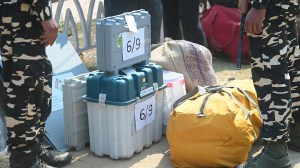Stay updated with the latest - Click here to follow us on Instagram
Why Delhi has been so humid this week
Easterly winds and little rainfall even after the monsoon hit Delhi has taken levels higher than the past week.
 “But heat index based on the combined meteorological calculations of temperature, humidity etc, is not being done because that has not been validated in India,” Mohapatra said. (Express photo: Tashi Tobgyal)
“But heat index based on the combined meteorological calculations of temperature, humidity etc, is not being done because that has not been validated in India,” Mohapatra said. (Express photo: Tashi Tobgyal)Easterly winds and little rainfall even after the monsoon hit Delhi has meant that the humidity levels in the city have been significantly higher over the past week, when compared to the previous one.
At the Safdarjung weather observatory, the average 24-hour maximum humidity recorded from July 1 to 8 was 87%, while the average minimum 24-hour humidity for the same period was 64%. In this period, the maximum humidity has not dropped below 74%, while the minimum humidity has remained above 52% on all days, according to data provided by the India Meteorological Department (IMD).
In contrast, the previous week was more comfortable. From June 24 to 30, the average maximum humidity was 70%, while the average minimum humidity was 42%. The humidity earlier in June, when parts of the city were in the midst of a heatwave, was even lower, with the maximum humidity at around 58% on June 5.
Easterly winds bringing moisture from the Bay Bengal set in once the monsoon has arrived contributing to high humidity levels, according to Dr Naresh Kumar, scientist, IMD. “Humidity is a very important factor in this season. The maximum temperature is less, but if humidity is high, it has an impact on human health,” he said. The impact of humidity is significant because high humidity means that sweat evaporates more slowly, making it more difficult for the body to cool down.
However, the IMD has not made the ‘heat index’ available so far. Kumar said, “At present in India, nobody is using the heat index. What is claimed to be used was developed in the USA, which is not fit for our climate. It needs to be developed.”
When asked about the heat index, IMD Director General Mrutyunjay Mohapatra said, “This type of index, we are developing based on past data. That will be available, perhaps, next year. Based on historical data of temperature, humidity, wind speed etc, we are preparing an index. Based on the index, we will be able to find out the heat hazard proneness of various districts. Most probably, by the next heatwave season, we will have this.”
“But heat index based on the combined meteorological calculations of temperature, humidity etc, is not being done because that has not been validated in India,” Mohapatra said.
He explained that the impact of heat depends on factors like relative humidity, wind speed and wind direction. “What we are doing is that under the heat action plan, certain cities like Ahmedabad, Bhubaneswar, Nagpur, state authorities, municipal authorities, IMD and medical departments are working together to provide temperature information and forecast and based on that, they are calculating what the ‘feel like’ temperature is. That’s being done by the NDMA (National Disaster Management Authority),” he added.
Kumar added about the heat index: “We are in the process of calculating…we have a heat hazard analysis map considering the different parameters. Maybe by the next heatwave season, it will be completed. However, all factors are considered while providing heat wave warnings.”
Going by the National Weather Service (NWS) of the USA, the heat index is “what the temperature feels like to the human body when relative humidity is combined with the air temperature”. The impact of high heat index ranges from fatigue to heat stroke, as listed by the NWS.
According to a paper published in 2017 in the Journal of Climate Change by scientists from the IMD and the Indian Institute of Tropical Meteorology, which analysed the heat index during the summer and monsoon, the heat index is increasing during the monsoon season at the rate of 0.32 degrees Celsius per decade.







